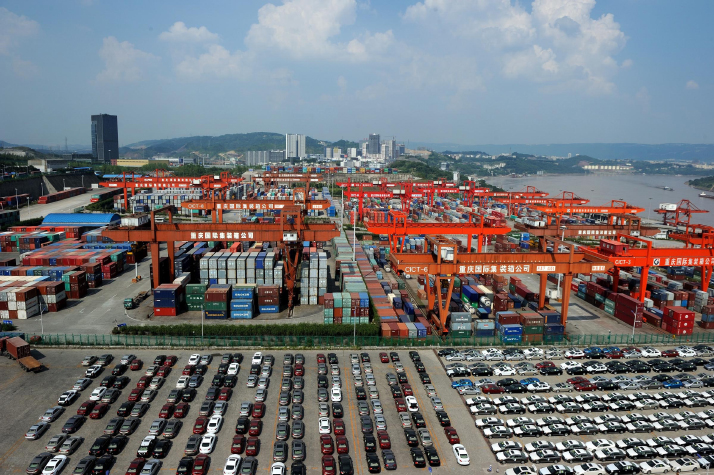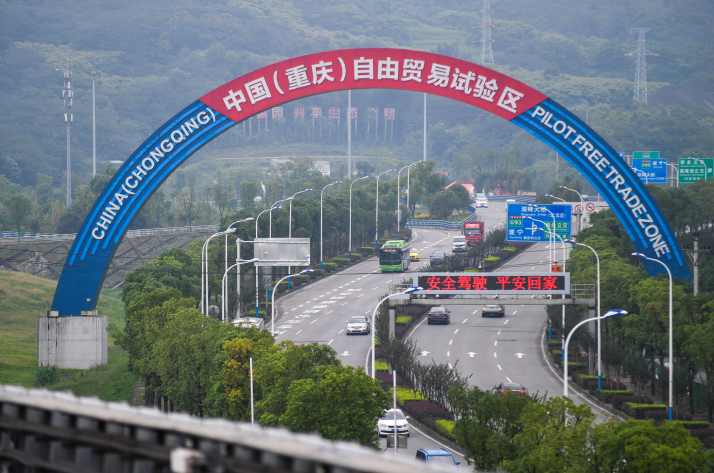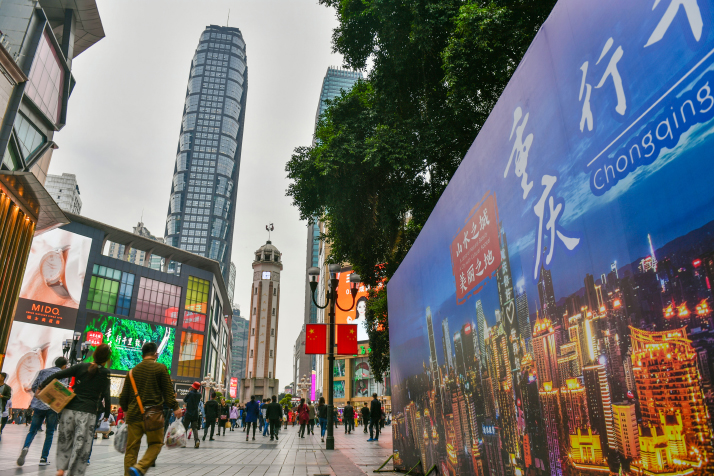| Business |
| Explorer of New Frontiers | |
| Chongqing capitalizes on its pilot free trade zone to transform industries | |
|
|
 A container terminal at the Chongqing Lianglu-Cuntan Free Trade Port Area (XINHUA)
A suburban industrial park closed off with customs checkpoints is an unlikely location for a gallery. But this is where Zhang Hang, a 38-year-old entrepreneur, has based his art company in Chongqing, a western metropolis with a population of more than 30 million.
The Hongyi Jiuzhou International Culture and Art Development Co. Ltd., founded in the Xiyong Area of the China (Chongqing) Pilot Free Trade Zone (FTZ) in May 2017, deals in artwork and cultural exchanges. Its exhibition halls house items ranging from embroideries and stone sculptures created by local handicraft makers to oil paintings by Italian, British and French artists. Zhang, from Guangdong Province in the south has been doing business in Chongqing for more than 10 years. "When I decided to pursue my career in Chongqing, my friends could hardly understand my choice," Zhang said. "Now they envy me for foreseeing business opportunities in the western region." Zhang's is one of the many companies poised to make the most of the potential Chongqing offers. As China's reform and opening-up program, launched 40 years ago and expanding from coastal regions to the hinterland, continues to advance, Chongqing is cashing in on the trend to explore new frontiers. The FTZ, inaugurated in April last year, has added wings to its progress.  A sign of the Xiyong Area of China (Chongqing) Pilot Free Trade Zone, Shapingba District (WEI YAO)
Exploring new realms
Zhang chose Xiyong for a reason. Foreign goods, including art, can enter the Xiyong Comprehensive Bonded Area, part of the FTZ, and be warehoused there without paying import duty. Only when they are purchased by domestic buyers and transported out of the area will customs clearance procedures start. Hongyi Jiuzhou is the first platform in west China and the third nationwide where cultural products are traded in a bonded area, according to Zhang. The other two are in Shanghai and Beijing. Domestic buyers can keep their foreign art purchases with the company before reselling them. Also, under the FTZ's policy on trade in cultural products, imported artwork can be taken out of the bonded area for exhibitions in Chongqing and elsewhere, tariff-free. But for this policy, exhibitors would have needed to go through complex procedures. The company also plays a role in introducing Chinese art overseas. It regularly conducts exchanges with foreign cultural institutions and consequently can help local artists, artisans and intangible cultural heritage practitioners promote their work internationally. In September 2017, Hongyi Jiuzhou showcased nearly 500 pieces of artwork in Paris. It was the first in a series of cultural exchange events to be held in countries involved in the China-proposed Silk Road Economic Belt and 21st-Century Maritime Silk Road Initiative, popularly known as the Belt and Road Initiative. The next exhibition will be in Russia. According to the Chongqing Municipal Commission of Commerce (CMCC), from April 2017 to June 2018, 16,985 new enterprises registered in the FTZ, higher than the total number in the previous three years. In the first half of this year, its import and export volume totaled 153 billion yuan ($22 billion), accounting for 67 percent of Chongqing's total. Paid-in foreign investment reached $3.4 billion, making up 79 percent of the total foreign investment in the city. For enterprises, the FTZ's appeal lies in easier access, fewer restrictions and greater policy support, said Liang Ming, Deputy Director of the Commerce Coordination Division of the CMCC. These are precisely the goals for FTZ reforms and innovations. Since the launch of the FTZ, Chongqing has taken several steps to facilitate customs clearance. For instance, imported seafood can now get the clearance in three hours. Before the FTZ was established, it used to take up to three days. This is due to reforms that have moved inspection facilities closer to logistics stations, Liang said. Also, priority is given to seafood and other products that have a relatively short shelf life. Apart from streamlining administrative procedures, Chongqing has other greater ambitions. It is trying to rewrite the rules of international railway cargo transportation. In shipping, letters of credit (LOC) issued by local banks to guarantee overseas sellers full payment are widely used, lessening the financial burden of importers. However, when it comes to cross-border railway transportation, risk-averse banks are reluctant to issue LOCs since unlike shipped cargo, which is delivered directly to the destination, railway containers are transported by trains of different countries along the way. Chongqing is exploring a new method in which a transportation agency takes responsibility for cargo safety and the railway station of entry ensures that the goods are released only after the LOC-issuing bank has received payment from the importer. With these assurances, a bank in Chongqing issued the first LOC for railway cargo in March. Liang believes this innovative arrangement can facilitate international trade and can be applied elsewhere. When it is widely used, the city would negotiate to make it an international practice, he said. Five years of enterprising and pioneering work in the country's pilot FTZs has seen major progress and breakthroughs in institutional explorations, President Xi Jinping said in late October. He urged more efforts to develop pilot FTZs to generate more replicable institutional innovations. China established its first pilot FTZ in Shanghai in 2013. Currently, there are 12 pilot FTZs across the country, where the government experiments with innovative ways of trade and investment facilitation. These experiences will be copied and spread on a larger scale, even nationwide, in the spirit of furthering reform and opening up.  The Jiefangbei Central Business District in Chongqing (WEI YAO)
Industrial evolution Situated on the upper reaches of the Yangtze River, Chongqing is the only municipality in west China that is directly under the administration of the Central Government. Covering 82,400 square km, it is five times as large as Beijing. Its population is also larger than that of the other three municipalities—Beijing, Tianjin and Shanghai. Chongqing has sought to inject impetus into its development through promoting the manufacturing industry and building links with other parts of the world, Liang said. In recent years, a number of leading laptop manufacturers have set up shop in Chongqing, making it the world's largest laptop manufacturing center. HP and Foxconn, the world's largest contract manufacturer of electronics devices, established a presence in the city in 2009, followed by other leading brands such as Acer. In order to help these companies export their products, Chongqing created cargo train routes to Europe. Today, they are part of the China-Europe freight rail service network, a flagship project under the Belt and Road Initiative. After the first Europe-bound container train chugged out of Chongqing in March 2011, a number of other cities followed suit. As of mid-October, there were 65 routes to 44 cities in 15 European countries. In 2017, the foreign trade volume by train from Chongqing accounted for 35 percent of the total China-Europe cargo train trade volume. By September, 2,375 trains had departed from Chongqing; and the number is estimated to exceed 3,000 by the end of this year or early next year. These trains transport cargo from around the country, with those originating in Chongqing accounting for 30 percent. In addition to logistics corridors, Chongqing found that it needed areas with special customs policies to boost the growth of export-oriented laptop manufacturers. In the Xiyong Comprehensive Bonded Area, for instance, manufacturers can assemble imported parts without paying tariffs, a policy that helps make their products more competitive.
Newly emerging industrial areas have transformed Chongqing's countryside. A new urban center is in the making in its western suburbs, including the Xiyong Comprehensive Bonded Area, Xiyong Micro-Electronics Industrial Park and Chongqing Logistics City, where the China-Europe freight train terminal is located and which is home to a host of logistics companies, as well as a university town. "Our industrial park was born in light of the need to develop logistics," Gu Xin, an official with Chongqing Logistics City, said. "However, as it keeps expanding, we aim to build it into a modern community with diverse programs, including commercial and cultural services, to meet the needs of the IT companies and universities in nearby areas." The FTZ incorporates Chongqing's existing industrial zones and provides a platform for the city to seek new ways of opening up, Liang said. He thinks convenient transportation is one of Chongqing's major advantages to pilot an inland FTZ. The city is expanding its transportation network, eyeing a new transportation corridor to Southeast Asia. An emerging network synergizing cargo routes to Europe and Southeast Asia will help it play a pivotal role in international trade. The new land-sea transit route is part of the China-Singapore (Chongqing) Demonstration Initiative on Strategic Connectivity signed in 2015. The initiative is the third intergovernmental program between the two countries following the Suzhou Industrial Park and Tianjin Eco-City. The route runs through Chongqing, Guangxi Zhuang Autonomous Region, and the provinces of Guizhou, Gansu and Qinghai, and is more cost-efficient than conventional marine routes. "As processing industries relocate to Southeast Asian countries in the wake of rising labor costs in China, the network will provide clothing manufacturers in Viet Nam and Malaysia with easy access to raw materials and markets," Liang said.
A painting on display at an exhibition hall of the Hongyi Jiuzhou International Culture and Art Development Co. Ltd. in Chongqing (WEI YAO) Moving up the ladder Unlike Zhang, who enjoys almost everything in his adopted city, semiconductor industry veteran Li Hong finds it difficult to adapt to Chongqing's humid climate and spicy food. But instead of complaining, he has been devoting most of his time to work and the diligence has paid off. Li, General Manager of China Resources Microelectronics (Chongqing) Ltd., has spearheaded the turnaround of a company that had been in the red for 10 years. The company, a manufacturer of silicon wafers used to produce integrated circuits, struggled to make ends meet. Then in December 2017, China Resources Microelectronics, based in Wuxi, east China's Jiangsu Province, took over. Li effected a change in the floundering company's business model by underlining the importance of research and development. Today, the company is moving up the value chain by developing its own products such as e-bike control systems. This flagship product of the company has grabbed nearly 60 percent of the domestic market, he said. "In the future, we will devote more resources to research and development to achieve long-term stable growth," Li said. Located in the Xiyong Micro-Electronics Industrial Park, the China Resources Microelectronics (Chongqing) compound is 40 hectares in area but only 40 percent of that is used. The company plans to build more wafer production lines, as well as facilities for integrated circuit packaging and testing. "It is a strategic decision to invest in Chongqing, a cornerstone for the development of central and west China," Li said. "Xiyong is a gathering place for leading microelectronics companies, who can be our potential clients and partners." Though confident about the future, Li is keenly aware of the blocks. The lack of talented personnel poses the most pressing challenge. It is estimated that the demand for professionals in the semiconductor sector will reach 700,000 in the three years to come, but the number available is only 400,000. That's why the company has partnered with universities in central and west China, encouraging students to study integrated circuits by providing scholarships, Li said. Assembling the best minds tops Liang's list of concerns as well. Chongqing's traditional pillar industries such as laptop and auto manufacturing are exhibiting signs of growth slowdown. It is time for the city to transition to higher ends of the industrial chain by introducing sophisticated technology such as smart manufacturing. While the FTZ presents opportunities, the challenge, again, lies in a shortage of talented people, Liang said. Compared with the eastern region, Chongqing suffers from brain drain and a dearth of technology-savvy professionals as well as those well versed in international laws and regulations. Without competent people, industrial upgrading will remain a pipedream. Education offers a solution. So Liang is calling for new colleges to nurture the badly needed talent. (Reporting from Chongqing) Copyedited by Sudeshna Sarkar Comments to yanwei@bjreview.com |
|
||||||||||||||||||||||||||||||
|